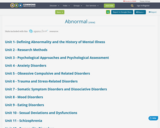
Selection of reading resources for Abnormal Psychology courses.
These resources were compiled by Dr. Susan Harvey, Professor at Delta College
- Subject:
- Life Science
- Material Type:
- Reading
- Date Added:
- 09/19/2018

Selection of reading resources for Abnormal Psychology courses.
These resources were compiled by Dr. Susan Harvey, Professor at Delta College

Introduction to the linguistic study of language pathology, concentrating on experimental approaches and theoretical explanations. Discussion of Specific Language Impairment, autism, Down syndrome, Williams syndrome, normal aging, Parkinson’s disease, Alzheimer’s disease, hemispherectomy and aphasia. Focuses on the comparison of linguistic abilities among these syndromes, while drawing clear comparisons with first and second language acquisition. Topics include the lexicon, morphology, syntax, semantics and pragmatics. Relates the lost linguistic abilities in these syndromes to properties of the brain.

This text is being developed for Abnormal Psychology lower division undergraduate courses. It is published now to allow students access to the course materials as it develops.

This is an Abnormal Psychology course at a community college. The syllabus outlines how the course is broken down by modules and possible discussion questions that could be used each week as students work through the material.
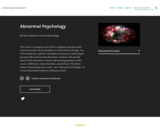
Short Description:
This course is designed to provide an engaging and personally relevant overview of the discipline of Abnormal Psychology. You will examine the cognitive and behavioral patterns which impair personal effectiveness and adjustment. Students will provide much of the substantive content and teaching presence in this course. Additional content has been curated from "The Noba Project (http://nobaproject.com/)" and "Abnormal Psychology: An e-text! (http://abnormalpsych.wikispaces.com/).
Word Count: 386820
(Note: This resource's metadata has been created automatically by reformatting and/or combining the information that the author initially provided as part of a bulk import process.)
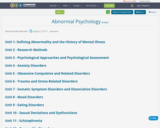
Selection of reading resources for Abnormal Psychology courses.
These resources were compiled by Dr. Susan Harvey, Associate Professor at Delta College
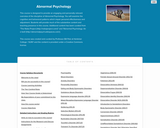
This course is designed to provide an engaging and personally relevant overview of the discipline of Abnormal Psychology. You will examine the cognitive and behavioral patterns which impair personal effectiveness and adjustment. Students will provide much of the substantive content and teaching presence in this course. Additional content has been curated from "The Noba Project (http://nobaproject.com/)" and "Abnormal Psychology: An e-text! (http://abnormalpsych.wikispaces.com/).
Openly-licensed course materials developed for the Open Educational Resources (OER) Degree Initiative, led by Achieving the Dream. https://courses.lumenlearning.com/catalog/achievingthedream
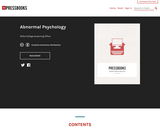
Abnormal Psychology is adapted from a work produced and distributed under a Creative Commons license (CC BY) in 2014 by OpenStax. This adapted edition is produced by Delta College through the OER Support Initiative
This adaptation comprises three chapters (Chapter 2 – Psychological Research, Chapter 14 – Stress, Lifestyle, and Health, Chapter 15 – Psychological Disorders) of the original text, chapters were reformatted to make the resulting product the starting point for an Abnormal Psychology course. This adaptation has not significantly altered or updated the original 2018 text.

This is a basic Introduction to Abnormal Psychology

Short Description:
This text has been created from a combination of original content and materials compiled and adapted from existing open educational resources.
Word Count: 112479
ISBN: 978-0-88880-654-3
(Note: This resource's metadata has been created automatically by reformatting and/or combining the information that the author initially provided as part of a bulk import process.)

This LibGuide was designed to accompany a community college course in Abnormal Psychology. It contains original material created by the instructor (Mind Maps and Focus Questions), as well as supporting readings gathered from other open sources and some links to freely available copyrighted material. Institutions with a subscription to the LibGuides platform may want to make a copy so they can adapt it to local needs and control the content.
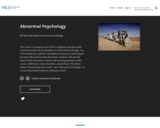
This course is designed to provide an engaging and personally relevant overview of the discipline of Abnormal Psychology. You will examine the cognitive and behavioral patterns which impair personal effectiveness and adjustment. Students will provide much of the substantive content and teaching presence in this course. Additional content has been curated from "The Noba Project (http://nobaproject.com/)" and "Abnormal Psychology: An e-text! (http://abnormalpsych.wikispaces.com/).

This resource is a video abstract of a research paper created by Research Square on behalf of its authors. It provides a synopsis that's easy to understand, and can be used to introduce the topics it covers to students, researchers, and the general public. The video's transcript is also provided in full, with a portion provided below for preview:
"Osteochondritis dissecans, or OCD, is a bone disease that wears away joints and the cartilage that covers them. It occurs most often in children and adolescents. While OCD has been documented and studied for nearly 150 years, researchers still don’t know what causes it. Reporting in The American Journal of Sports Medicine, one group offers up new findings that point to at least one factor that surgeons should look out for. The team looked at radiographs of 61 knees of patients undergoing surgery for OCD. Those patients were just over 23 years old on average, and 77% of them were men. The researchers reviewed the radiographs for mechanical alignment, as previous studies have speculated that deformities due to malalignment contribute to OCD. What they found was that patients with OCD did in fact show signs of off-axis effects. Specifically, they observed that the location of OCD lesions correlated with the deviation of the mechanical axis of the leg..."
The rest of the transcript, along with a link to the research itself, is available on the resource itself.
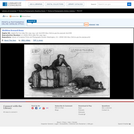
A satire on enforcement of the "gag-rule" in the House of Representatives, prohibiting discussion of the question of slavery. Growing antislavery sentiment in the North coincided with increased resentment by southern congressmen of such discussion as meddlesome and insulting to their constituencies. The print may relate to John Quincy Adams's opposition to passage of the resolution in 1838, or (more likely) to his continued frustration in attempting to force the slavery issue through presentation of northern constituents' petitions in 1839. In December 1839 a new "gag rule" was passed by the House forbidding debate, reading, printing of, or even reference to any petition on the subject of abolition. Here Adams cowers prostrate on a pile composed of petitions, a copy of the abolitionist newspaper the "Emancipator," and a resolution to recognize Haiti. He says "I cannot stand Thomson's [sic] frown." South Carolina representative Waddy Thompson, Jr., a Whig defender of slavery, glowers at him from behind a sack and two casks, saying "Sir the South loses caste whenever she suffers this subject to be discussed here; it must be indignantly frowned down." Two blacks crouch behind Thompson, one saying "de dem Bobolishn is down flat!" Weitenkampf cites an impression with an imprint naming Robinson as printer and publisher, this line being apparently trimmed from the Library's impression. The drawing style and handling of the figures strongly suggest that "Abolition Frowned Down" is by the same Robinson artist as the anonymous "Called to Account" and "Symptoms of a Duel" (nos. 1839-10 and -11).|Drawn by HD?|Entd . . . 1839 by H.R. Robinson . . . Southn. Dist. of N.Y.|Title appears as it is written on the item.|Weitenkampf, p. 59.|Forms part of: American cartoon print filing series (Library of Congress)|Published in: American political prints, 1766-1876 / Bernard F. Reilly. Boston : G.K. Hall, 1991, entry 1839-12.
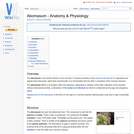
The abomasum is the fourth chamber in the ruminant. It functions similarly to the carnivore stomach as it is glandular and digests food chemically, rather than mechanically or by fermentation like the other 3 chambers of the ruminant stomach.

Esse Recurso Educacional Aberto disponibiliza materiais para os alunos navegarem e aprenderem mais sobre música de uma maneira dinâmica. Os materiais são acompanhados de vídeos e de outras mídias. Podem servir também como um guia didático destinado aos professores de música.

Aboriginal Hand Print
(art + history; art + social studies)
"One old man in Arnhem Land remembered being carried as a child on his father's shoulders as his father climbed up a log leaning against a rock wall. His father then sprayed his hand with red ochre against the rock, leaving a stencil he could still recognize many years later. The main function of the stencils was to record people's presence and association with a site." — Aboriginal Art Online
The stenciled hand print and aboriginal style drawings help children to relate to the man from the Australian Aboriginal Culture stated above, while helping them to understand the use of line in art. A black paper with white splattered paint was used, but white paper with red (ochre) splattered paint would make a nice impression also. Construction paper crayons make bright, bold, linear designs around the hand stencil.
Grade Levels K-4
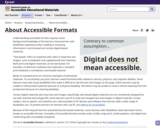
Understanding accessible formats requires some background knowledge of the barriers many learners with disabilities experience when reading or accessing information in print-based and certain digital-based materials.
"Text-based" refers to materials with static or fixed text and images, such as textbooks and supplemental text materials. Both print and digital materials can be text-based. For example, an electronic textbook that replicates a standard print textbook is considered a text-based material.
Books in standard print are common examples of text-based materials. To successfully use print, learners need functional skills related to sensory, physical, and cognitive abilities. Some learners may have visual disabilities that make it difficult to see the text and images on the page. Other learners may be unable to hold printed materials because of a physical disability. Still others may be unable to read or derive meaning from the printed text because of a learning disability.
Certain digital materials also have text and images. Specifically, text-based digital materials are not consistently designed for use with assistive technology (AT). Some learners use AT to read and navigate text and images in digital materials. Screen readers, text to speech, and switches are a few examples of AT devices and software that learners with a wide range of disabilities use. To prevent barriers for learners who use AT, see Vetting for Accessibility.
Because of the frequent barriers presented by text-based materials, some learners with disabilities need alternative forms, known as accessible formats. Examples of accessible formats include audio, braille, large print, tactile graphics, and digital text conforming with accessibility standards.
The term accessible format is defined in section 121 of the Copyright Act, known as the Chafee Amendment:

Students learn about the concepts of accuracy and approximation as they pertain to robotics, gain insight into experimental accuracy, and learn how and when to estimate values that they measure. Students also explore sources of error stemming from the robot setup and rounding numbers.

The Apache Crown Dancers are enrolled members of the White Mountain Apache Tribe and live in Whiteriver, Ariz. In this video segment, the group leader, Joe Tohonnie, Jr., talks about the long history of the dance and its role in Apache culture as the dancers perform Crown Dances.